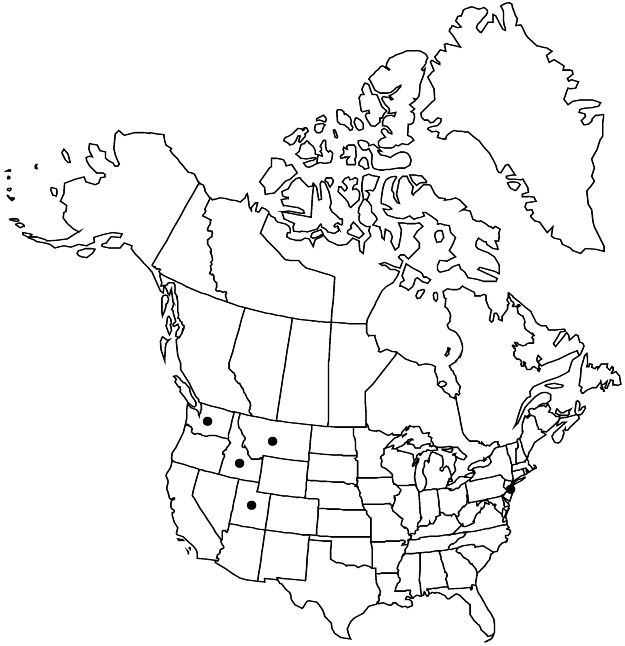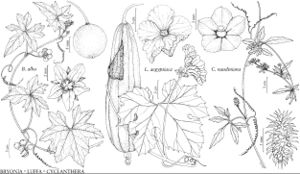Difference between revisions of "Bryonia alba"
Sp. Pl. 2: 1012. 1753.
FNA>Volume Importer |
imported>Volume Importer |
||
| (6 intermediate revisions by 2 users not shown) | |||
| Line 10: | Line 10: | ||
|special_status={{Treatment/ID/Special_status | |special_status={{Treatment/ID/Special_status | ||
|code=F | |code=F | ||
| − | |label= | + | |label=Illustrated |
}}{{Treatment/ID/Special_status | }}{{Treatment/ID/Special_status | ||
|code=I | |code=I | ||
| Line 31: | Line 31: | ||
|elevation=100–1800 m | |elevation=100–1800 m | ||
|distribution=Idaho;Mont.;N.J.;Utah;Wash.;Europe;Asia;introduced also in n;e Europe (Czech Republic;Denmark;Finland;Lithuania;Poland);Pacific Islands (Hawaii). | |distribution=Idaho;Mont.;N.J.;Utah;Wash.;Europe;Asia;introduced also in n;e Europe (Czech Republic;Denmark;Finland;Lithuania;Poland);Pacific Islands (Hawaii). | ||
| − | |discussion=<p>Bryonia alba has been naturalized in the United States since the 1880s and may have been introduced through commercial seed trade. A tincture from the roots has been widely used as an effective diuretic. The seeds are dispersed by birds.</p><!-- | + | |introduced=true |
| − | --><p>As noted by C. Jeffrey (1969), Bryonia alba is monoecious in northern Europe, as it seems consistently to be in the flora area; it is commonly dioecious in the southeastern part of its native range (Macedonia to Turkey and southwestern Russia).</p><!-- | + | |discussion=<p><i>Bryonia alba</i> has been naturalized in the United States since the 1880s and may have been introduced through commercial seed trade. A tincture from the roots has been widely used as an effective diuretic. The seeds are dispersed by birds.</p><!-- |
| − | --><p>Measurements from relatively few collections suggest that peduncles of Bryonia alba are longer in Europe (4–14 cm) than in North America (2–3 cm).</p> | + | --><p>As noted by C. Jeffrey (1969), <i>Bryonia alba</i> is monoecious in northern Europe, as it seems consistently to be in the flora area; it is commonly dioecious in the southeastern part of its native range (Macedonia to Turkey and southwestern Russia).</p><!-- |
| + | --><p>Measurements from relatively few collections suggest that peduncles of <i>Bryonia alba</i> are longer in Europe (4–14 cm) than in North America (2–3 cm).</p> | ||
|tables= | |tables= | ||
|references={{Treatment/Reference | |references={{Treatment/Reference | ||
| Line 48: | Line 49: | ||
-->{{#Taxon: | -->{{#Taxon: | ||
name=Bryonia alba | name=Bryonia alba | ||
| − | |||
|authority=Linnaeus | |authority=Linnaeus | ||
|rank=species | |rank=species | ||
| Line 63: | Line 63: | ||
|publication title=Sp. Pl. | |publication title=Sp. Pl. | ||
|publication year=1753 | |publication year=1753 | ||
| − | |special status= | + | |special status=Illustrated;Introduced |
| − | |source xml=https:// | + | |source xml=https://bitbucket.org/aafc-mbb/fna-data-curation/src/2e0870ddd59836b60bcf96646a41e87ea5a5943a/coarse_grained_fna_xml/V6/V6_11.xml |
|genus=Bryonia | |genus=Bryonia | ||
|species=Bryonia alba | |species=Bryonia alba | ||
Latest revision as of 22:19, 5 November 2020
Vines monoecious, high-climbing or forming dense mats over vegetation, to 7 m. Leaves: petiole 1.5–3.5 cm; blade hastate to 5-angular, palmately 3–5-lobed, 3–8(–15) × 2–6(–8) cm, lobes ovate to deltate or triangular, central lobe largest, base deeply cordate, margins coarsely dentate to remotely dentate or serrate, surfaces hispidulous to scabrous or pustulate, not white-sericeous abaxially. Flowers: calyx campanulate; sepals recurving, whitish, green-veined, lanceolate, 3.5–5 mm; petals yellowish to greenish white, oblong-ovate, 3–7 mm; stigmas glabrous. Fruits 4–6(–10), black, 0.6–1 cm, peduncles 2–3[–14] cm. Seeds 2–6(–8), 4–5 × 2 mm. 2n = 20.
Phenology: Flowering Jun–Aug.
Habitat: Sagebrush, riparian zones, thickets, stream terraces, irrigation ditches, seeps, moist slopes, draws, lawns, roadsides, fencerows, picnic areas, disturbed sites
Elevation: 100–1800 m
Distribution

Introduced; Idaho, Mont., N.J., Utah, Wash., Europe, Asia, introduced also in n, e Europe (Czech Republic, Denmark, Finland, Lithuania, Poland), Pacific Islands (Hawaii).
Discussion
Bryonia alba has been naturalized in the United States since the 1880s and may have been introduced through commercial seed trade. A tincture from the roots has been widely used as an effective diuretic. The seeds are dispersed by birds.
As noted by C. Jeffrey (1969), Bryonia alba is monoecious in northern Europe, as it seems consistently to be in the flora area; it is commonly dioecious in the southeastern part of its native range (Macedonia to Turkey and southwestern Russia).
Measurements from relatively few collections suggest that peduncles of Bryonia alba are longer in Europe (4–14 cm) than in North America (2–3 cm).
